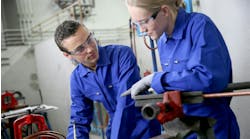Latest from Management
Sponsored
Reading today’s trade magazines is an adventure in emerging digital technology as it applies to our industry. The introduction of new and, frankly, amazing products and programs occurs at a pace which is hard to imagine, especially if you have been in the trades for longer than twenty or more years.
If you have been in the industry for that long, you know that change comes very slowly, or at least it always has before now. Many “innovations” in product or technique are resisted by both the powers that regulate our trade (read: plumbing inspectors, municipal officials, etc.) and by the tradesmen themselves. There is a good reason for this. It has been proven, over time, that new products come on the market with new methods of installation that are not as tried and true as they ought to be.
The people who pay for the failures of those new and emerging products are the plumbers, pipefitters and HVAC guys who sell, purchase and install them. The industry is rife with the bones of products that have been brought to market but do not perform as advertised in actual field conditions. The end result is that the plumber or HVAC technician is the one who gets the black eye, so caution is the word of the day when it comes to jumping on the ‘new and improved’ product bandwagon.
That is one reason that change is resisted by the trade. Another reason is human nature. “That’s the way we have always done it!” is a mantra most of us have become familiar with in the industry. So when a change is warranted, and is tried and true, it becomes an accepted part of the industry that we can all agree on.
When products like No-Hub Cast Iron, PVC, ABS DWV came out, they were given the “hairy eyeball” by most municipalities, and the inspectors who enforced code compliance. Pressure by the manufacturers, at a political level, pushed those particular products until they were accepted in the field. Still, shops who chose to install these new materials were subject to the most mercurial and draconian installation procedures by the inspectors.
This was not because of some nefarious payoff scheme, but because the inspectors were not sure about the materials and could only go by the manufacturers literature when it came to how the materials were to be installed. A lot of the time, those instructions were ambiguous and open to interpretation. Inspectors—like every other political animal field mechanics have had to deal with—are not risk-takers. If a product called for several methods of installation, it was not uncommon for an inspector to require use of all of them!
Now, in most cases, the products were actually superior to the then prevailing material they were designed to replace. It just took a long time for them to be accepted, and for everyone, journeymen and inspectors, to get used to seeing them and understanding any particular requirements for proper installation. Once that happened it was back to business as usual.
If you are old enough to remember installing an underground soil system using hub and spigot cast iron with lead and oakum joints and then being allowed to use No-Hub, you get my drift here. The difference in labor alone was so significant that it made no financial sense to use the older method. Hot on the heels of that innovation, ABS and PVC DWV piping came on the scene, and they made our jobs even less labor intensive.
Still, the municipalities resisted the new products and restricted the plastics to use in residential construction only, as well as limiting those products to single story structures. It took over twenty years for plastic DWV piping to be fully allowed in commercial buildings and even today there are instances where it is still restricted for reasons that vary from fire code to “because we said so.”
The upshot of all this resistance and slow change is that it protects the end user as well as the guy who installs the product and the jurisdictions where the products are installed from product failure problems, recalls, bad publicity and lawsuits to the extent that it is possible in today’s litigious society.
Considering the foregoing, how does the new digital technology that we see on every page or article of every trade publication measure up to scrutiny? That question may be very hard to answer.
There are so many new digital productivity programs being advertised today that is difficult, at best, to determine which products work as advertised, and which are merely window dressing or hollow imitations of those that do. If we apply the foregoing yardstick to these digital programs, and then factor in the speed of change it becomes clear that there are, or will be, a bunch of these programs that will not survive.
As an example, there are many AI related programs that purport to help keep your trucks and drivers safer by tracking drivers’ habits, controlling timing, speed, etc. Some actually do that. Others act more like Big Brother and just spy on the journeyman while pretending to make driving safer.
It is not a very good feeling to think that you are being watched at all times or (as an example) to be questioned by the office as to why you stopped where you did so long, etc. In fact, the sensibilities of field personnel do not seem to be taken into consideration at all by the users of this type of software. In my opinion, this is a big mistake and will eventually not end well for those using that technology. I could be wrong, but I wouldn’t like it if it were applied to me.
Many in today’s workforce are at least partially familiar with the digital world, as they have grown up with it and are more accepting of the intrusiveness of these types of programs. Changes in personal space and privacy seem to be occurring at a very rapid pace. Perhaps it is inevitable that digital and AI-related technology will integrate into our trade—just as the products that were mentioned earlier in this article have been—and become the norm.
How our workforce accepts and adapts to this new paradigm will be interesting to monitor moving forward. Is it a “brave new world” or just the march of technology? You decide.
The Brooklyn, N.Y.-born author is a third-generation master plumber. He founded Sunflower Plumbing & Heating in Shirley, N.Y., in 1975 and A Professional Commercial Plumbing Inc. in Phoenix in 1980. He holds residential, commercial, industrial and solar plumbing licenses and is certified in welding, clean rooms, polypropylene gas fusion and medical gas piping. He can be reached at [email protected].
Al Schwartz | Founder
The Brooklyn, N.Y.-born author is a retired third generation master plumber. He founded Sunflower Plumbing & Heating in Shirley, N.Y., in 1975 and A Professional Commercial Plumbing Inc. in Phoenix in 1980. He holds residential, commercial, industrial and solar plumbing licenses and is certified in welding, clean rooms, polypropylene gas fusion and medical gas piping. He can be reached at [email protected].


